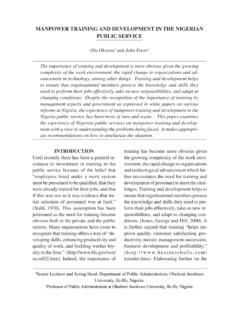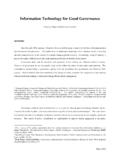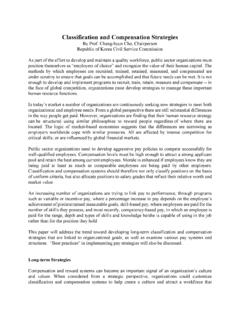Transcription of Organizational Performance Management and …
1 Organizational Performance Management and Measurement The Lebanese Experience Hanine Salem Performance Improvement Planning Consultant Beirut July, 2003 2 Organizational Performance Management and Measurement is one of the most popular terms in today s public sector Management terminology. The idea of managing Organizational Performance is being widely accepted and adopted all over the world. It spread rapidly from the private sector to the public sector in the developed world and has recently found its way in many developing countries. New initiatives and legislations continue to being issued as a sign of governments insistence on following the new focus on Performance orientation.
2 Performance is referred to as being about doing the work, as well as being about the results achieved. It can be defined as the outcomes of work because they provide the strongest linkage to the strategic goals of an organization, customer satisfaction and economic contributions. The term Performance Management and Measurement refers to any integrated, systematic approach to improving Organizational Performance to achieve strategic aims and promote an organization s mission and values. In that sense Organizational Performance Management is quite different than individual Performance Management which specifically targets the personal Performance of an employee although the latter comprises an essential part of the overall Organizational Performance framework.
3 In fact, a Performance Management system aims at improving the results of people s efforts by linking these to the organization s goals and objectives. It is, ideally, the means through which employees Performance can be improved by ensuring appropriate recognition and reward for their efforts, and by improving communication, learning and working arrangements. Many Performance Management systems borrow from or utilize some of the new approaches such as Balanced Scorecard , Total Quality Management (TQM), best practice Benchmarking , or Business Process Re-engineering (BRP). Performance Measurement must be considered as part of the overall Performance Management system and can be viewed as the process of quantifying the efficiency and effectiveness of actions.
4 It is common practice in 3public sector Performance Management literature to talk about the three Es of: Economy, Efficiency, and Effectiveness. A good Performance measurement approach should consider measuring and assessing the three Es: Economy: Procurement and delivery of inputs Human, physical and financial resources Quantity and quality Cost element Timeliness Operational level Efficiency: The optimal transformation (activities) of inputs into outputs (UNDP) Utilization of means to achieve results and objectives Rational use of resources Least costs maximum results / return Activities in perspective of results Work planning and timelines Tactical levels Effectiveness: The extent to which a program or project achieves its immediate objectives or produces its desired outcome (UNDP) Achievements of results, objectives, goals Focus on target groups, beneficiaries, clients Medium and long-term perspective Much more difficult to measure and assess Strategic level 4 Historical Background: Performance Management and measurement systems developed as a means of monitoring and maintaining Organizational control, which is the process of ensuring that an organization pursues action plans that lead to the achievement of overall goals and objectives.
5 These goals should in turn be direct manifestation of the mission and strategic orientation of an organization. At its outset, Performance measures were concerned with inputs aspects, mainly financial resources, a practice that was later criticized and mostly abandoned. As such, the earliest roots of Performance Management can be traced back to the use of cost benefit analysis in the 1960s; to Management by objectives (MbO) in the 1960s and 1970s; and to output budgeting in the 1960s. Most of these initiatives, however, were regarded as experimental and some were only adopted as one-off exercises. Throughout the 1960s and the 1970s, a long interval of almost twenty years, much talk took place about introducing Performance Management into the public sector.
6 It was clear by the 1980s that interest in Performance Management has moved from the ivory towers of academia to the corridors of government around the world. Towards the end of the 1980s, many systems of Performance Management were born, adopted and implemented at many levels of the public sector. By that time, traditional Performance measures, those developed from costing and accounting systems, have been criticized for encouraging short termism, lacking strategic focus, and not being externally focused. In an attempt to overcome these criticisms, Performance Management frameworks have been developed to encourage a more balanced view between internal and external factors, financial and non-financial measures.
7 These Multi-dimensional frameworks focused more on non-financial information and are designed to provide a balance by including measures of external success as well as internal Performance , and measures which are designed to give an early indication of future business Performance as well as a record of what has been achieved in the past. The four perspectives of the Balanced Scorecard approach represent 5one of the most prominent examples of these frameworks. Another example is the use of the market as a bench mark for comparison of Performance (or as an ultimate threat in the case of perceived persistent low performers). These models of Performance Management may be said to comprise the Anglo-Saxon model, identified principally with the United States, Canada, the United Kingdom, Australia, and New Zealand although some differences in emphasis and approach are evident between these countries.
8 Around almost the same time, a growing interest in the assessment and improvement of quality in public services became evident at these countries. Gradually, the quality dimension became an essential part of most, if not all, Performance Management systems. Interest in quality Management approaches became evident within many public agencies towards the late 1980s. However the drive towards quality took off in earnest in the early 1990s after the publication of the UK s Citizen s Charter in 1991 and the United States Reinventing Government in 1993. The Citizen s Charter is said to embody six key principles of public services, emphasizing the importance of standards, information and openness, choice and consultation, courtesy and helpfulness, putting things right, and value for money.
9 The US s Reinventing Government is structured around many principles heavily related to Performance Management with a strong focus on quality of services. In both examples, measurement of Performance is to be done by using a number of Performance Indicators (PIs) as external mechanisms that reflect each government s strategic choices and sets of priorities as far as quality of services is concerned. There are other managerial roles for PIs besides giving strategic direction (public entities are held accountable as to whether they pursued these directions strategic or policy accountability). Other roles include resource allocation (whether they allocated budgets in line with best available information value-for-money accountability), exercising control (whether they spent these budgets in line with guidelines on probity and regularity financial accountability), and encouraging learning (how their Performance and achievement compares to that of other similar public entities, both locally and internationally bench marking accountability).
10 6 This rather new focus on quality of services and the integration of that aspect into Performance Management systems was accompanied by serious efforts to follow up on progress in implementing the resulting programs. This explains the resulting growing interest in annual reports that helped ministers keep a series of high profile announcements highlighting their achievements. There was a strong move toward increased publication of Performance information , preferably according to a centrally designed format. Standardization of reports was viewed as a facilitating tool that better enables citizens to compare between different reports. Many countries announced principles and guidelines for reporting down to the very detail of paper weight and margins specifications.
















